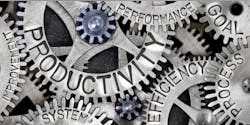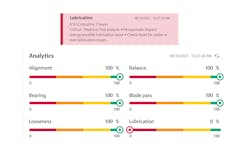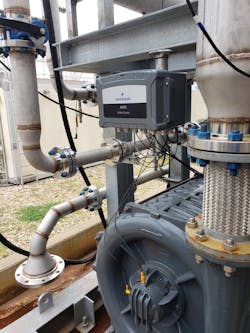Four Reliability Strategies to Overcome Process Manufacturing Performance Roadblocks
For most chemical manufacturers, competitive edge is critical. In an increasingly global marketplace, standing out against the competition requires a careful balance of cost, quality and availability—requiring efficient process manufacturing. At the heart of that balance is effective reliability and maintenance of equipment across individual plants, and often entire fleets. The most effective organizations set clear maintenance and reliability goals, with reliance on leadership to keep a finger on the pulse of plants to ensure they reach those goals.
This was typically easier 20 years ago when expert personnel were plentiful and manufacturing sites were more localized. Today, however, expert personnel are retiring in droves, and bringing new personnel up to their level is a career-long endeavor, not the work of just a year or two.
For one chemical manufacturer operating numerous plants across many world areas, the problem of inexperienced personnel and poor overall equipment effectiveness (OEE) had become an unbreakable loop. Inexperienced operators were running equipment in a manner that lowered reliability beyond the normal lifecycle operation, and inexpert technicians were unable to quickly identify and remedy issues with equipment. Ultimately, plants faced shutdowns, which created efficiency problems, leading the operators to push equipment even harder. The problems created a never-ending spiral of inefficiency and equipment failure.
Here are a few strategies that helped the organization reduce waste, increase throughput and maintain quality.
Identify Immediately Solvable Problems
A top-down initiative included difficult-to-achieve production goals, requiring the reliability and maintenance teams to improve overall performance. Leadership performed a high-level root cause analysis to isolate problems, many of which occurred because operating with inexperienced personnel led to equipment reliability issues.
One of the very first steps was determining where personnel experience gaps existed, and then identifying ways to close those gaps—typically by the strategic application of various technologies (Figure 1).
For example, one common problem across plants occurred when inexperienced operators moved product from one vessel to another. In many cases, operators would run tank levels too low while transferring product, and when the tanks would empty, the pumps would run dry, causing them to cavitate.
The cavitation of the pumps created high-frequency vibrations that ultimately damaged the rotating elements and bearings, as well as the impellers. As a result, the reliability of the equipment degraded rapidly because the impeller damage would take the pump off its optimal operating curve, reducing the efficiency of the process. These problems led to shutdowns, reduced quality, and wasted product.
The reliability and maintenance team determined that instrumenting equipment with modern smart sensors containing built-in analytics, operators and technicians of any experience level could easily see when equipment began to fail. Those same technologies would also help them identify the root cause of problems as they occurred, giving them a chance to intervene before they caused failures.
When the reliability team equipped tanks with wireless sensors with built-in edge analytics, the process became far less likely to cause damage to the pumps. If the pumps began to run dry, the condition monitoring software immediately triggered a vibration notification, alerting the operators to the problem, with plenty of warning to adjust the process before cavitation occurred.
Quick ROI Builds Momentum
At the start of their project, management had come to the reliability team with lofty production goals and concerns about the diminishing workforce, challenging them to come up with a plan. The team knew they needed to avoid a “program of the day” scenario where they implemented a program, only to abandon it a few months or years later. To ensure success, the team needed to build a solution that would be scalable and could be implemented using an evolutionary process.
The solution was to start with small projects with fast return on investment (ROI) to gain momentum. The team started with easy projects that were critical to leadership’s vision. In most cases, these pilot projects consisted of new assets and process loops. As the team would add equipment such as agitators, pumps and vessels, they would also incorporate new sensing technologies to help them quickly identify equipment degradation and failure, and to provide inexperienced personnel with guidance to remedy impending issues (Figure 2).
In one case, the team implemented a continuous monitoring solution that immediately identified that a new pump was not operating on its optimal curve, creating a significant risk of pump cavitation. The team was able to immediately resize the impeller on the pump, and then confirm it operated per design. Without the insights from automated condition monitoring, the operations team would have been running at lower efficiency and toward premature equipment failure from day one.
In another example, the team installed sensors on a new agitator. They then used intuitive asset health data provided by the sensors to identify that the operations team was running the agitator in a manner reducing its operational life due to loading and bearing wear. The team presented its findings to leadership and operations, who adjusted the control system to operate the agitator at a different rate and load setting for better long-term performance.
As the reliability team found success with small, targeted initiatives in new installations, they were also able to use the lessons learned as teams updated control and monitoring of existing equipment. In some cases, these modernizations would have happened on schedule and were simply improved by technologies and lessons from other projects. In other cases, modernization projects were started with the specific intent to gain the advantages of new technologies proven in similar applications.
Like many process manufacturers, the organization continues to buy the same equipment across its many plants, and the agitator was no exception. The agitator was one of hundreds of identical items across their fleet. Staff were therefore able to take the lesson learned and confirm proper operation in many other plant areas with similar setups. One small project had an impact across an entire fleet, potentially saving millions of dollars across the enterprise.
Match Technology to Criticality
The most successful projects begin with thorough assessments, and reliability and maintenance initiatives are no exception. Delivering fast ROI on condition monitoring initiatives requires teams to identify the right sensing and analytics technologies for application to the right equipment.
Like many manufacturers, the chemical manufacturer did not have the deep staff of personnel with extensive knowledge of plant equipment needed to perform an evaluation of all plant assets for a criticality assessment.
Working with their automation supplier, the team identified three categories of assets: critical assets, essential assets and balance-of-plant. The critical asset group consisted of equipment that, upon failure, would shut down the plant or cause environmental or safety concerns. This equipment needed to run reliably 24x7 to ensure safe and efficient production. Essential assets were items that could cause stoppages that could be circumvented with spare equipment or changes in operation. The team needed these assets to run reliably, but they had options in the event of failure. Balance-of-plant equipment consisted of assets that were important and significantly affected throughput but would not cause outages upon failure.
The most critical assets in the plant were equipped with machinery monitors to provide continuous condition monitoring for 24x7 visibility into asset health. This continuous monitoring provided real-time health prediction in addition to equipment protection.
Essential assets were monitored using edge analytics devices. These sensors were installed at the asset to perform powerful analytics at the edge. The edge devices converted machine health data, such as spectrum and waveform readings, into actionable information, empowering even inexperienced operators and technicians to identify potential failures and root causes.
Balance-of-plant equipment was fitted with small wireless vibration monitors to provide full spectrum and waveform data, as well as basic and intuitive health scores to help operators and technicians monitor their machines with confidence (Figure 3).
As the chemical manufacturer expanded its operations, it performed criticality assessments on all new projects to ensure the team implemented the condition monitoring equipment that was most effective and would deliver the fastest ROI. The team also consistently reviewed the equipment in use to ensure it continued to deliver value through cost savings and improved OEE.
Understand What Success Means
As mentioned previously, a core goal of the chemical manufacturer’s improvement strategy was to avoid creating a “program of the day” approach to maintenance and reliability. The reliability and maintenance teams knew success hinged on the ability to demonstrate value not only weeks after projects, but across the entire lifecycle of the new equipment. If the team could regularly generate fast ROI, they could continually put forward cost savings, program improvements and workflow and work process improvements that demonstrated value for each of the manufacturing sites. This regular demonstration of ROI would keep up the momentum for further investment, helping the project become a cultural shift, rather than a passing organizational fad.
The team identified a cadence for regular management reports to show progress made on new initiatives. In one example, sensors attached to an essential air intake fan identified a serious vibration increase, which occurred only on cold mornings. The site had very few skilled vibration analysts on staff and sending additional support to the site to analyze the problem would not be possible for an extended time. In the past, the plant likely would have had to slow or shut down production due to the reduced air intake.
When they saw the vibration reported by the edge analytics device attached to the fan, the team was immediately able to rule out many of the most common causes. The elimination of common causes led the team to check the intakes on the top of the building—a step that normally would have been one of the last performed due to the cold weather—where they discovered ice on the intake was starving the fans of air and creating turbulence. The team had plenty of time to perform service due to the early warning from condition monitoring equipment (Figure 4).
The success of the team led the rollout of the same technology in similar setups in other cold-weather locations to prevent similar failures across the fleet. Each winter, the team was able to demonstrate the value added by faster warning to weather-related degradation of conditions, helping ensure management would not only continue to support those condition monitoring projects, but also expand them in the future.
Every project implemented by the chemical manufacturer was continuously evaluated alongside an expert vendor partner. Working with subject matter experts from their automation vendor, the reliability and maintenance teams would regularly reassess every new initiative. If it was working optimally, they would identify where the company could add more value by rolling it out to other assets. If it was working but could be better, they would identify ways to improve technologies and the way they were used. If a project was not working, they would bring all hands on deck to identify the roadblocks to success. The team not only challenged themselves, but also continuously challenged their automation partner to help them achieve disruptive improvements in their processes.
Start Small But Start
Most chemical manufacturing sites do not have the reliability expertise on staff to meet or exceed their production goals. While many of these sites are bringing on new staff to help replace those lost to retirement, it will be years or even decades before that personnel can not only improve performance at their location but also help drive efficiency and performance increases across the enterprise.
Fortunately, modern condition monitoring technologies with embedded analytics software can help close the experience gap. By partnering with an automation expert to help establish standards and ensure consistent deployment on rollout, reliability and maintenance teams can start by successfully completing small projects that can be scaled to provide enterprise-wide performance improvements and decision-making support.
About the Author





